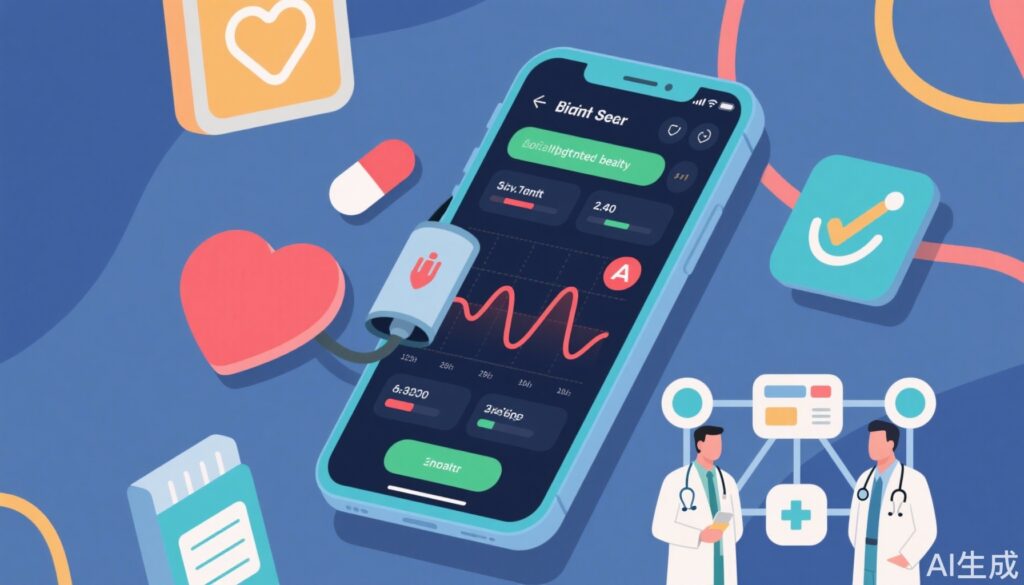Highlights
- The SMART-BP randomized trial confirmed that a mobile app incorporating tailored feedback significantly lowers home systolic blood pressure and improves medication adherence compared with self-monitoring alone.
- Systematic reviews and meta-analyses reaffirm the efficacy of home blood pressure monitoring (HBPM) in diagnosing and managing hypertension, enhancing patient compliance, and potentially reducing healthcare costs.
- Pharmacologic advances, including sacubitril/valsartan and combination therapies, demonstrate improved blood pressure control and safety profiles in diverse hypertensive populations.
- Despite high hypertension prevalence worldwide, control rates remain suboptimal, emphasizing the need for multifaceted approaches integrating technological, pharmacological, and public health strategies.
Background
Hypertension remains a leading modifiable risk factor for cardiovascular disease and premature mortality globally. Despite available effective pharmacotherapies and guidelines, blood pressure control is often inadequate due to medication nonadherence, suboptimal monitoring, and systemic barriers. Traditional clinic-based blood pressure measurement can be limited by white-coat effects and infrequent assessments. Self-monitoring of blood pressure (SMBP) at home using validated devices has emerged as a valuable adjunct, yielding more reliable data and patient engagement in care. However, enhancing SMBP with interactive, tailored feedback through digital platforms promises further improvement in hypertension management and adherence. The SMART-BP randomized clinical trial investigated whether a mobile app providing algorithm-driven alerts and recommendations based on SMBP data achieves superior outcomes compared to SMBP alone in patients with uncontrolled hypertension.
Key Content
Evidence From the SMART-BP Randomized Clinical Trial
The trial enrolled 184 adults aged ≥19 years with uncontrolled hypertension across multiple centers from September 2019 to July 2020. Participants were randomized to either SMBP plus a mobile app with feedback (n=97) or SMBP alone with an app that only recorded home BP measurements (n=87). The intervention app included features such as measurement reminders, alerts for elevated BP values, and tailored lifestyle and medication adherence recommendations. The primary endpoint was change in mean home systolic blood pressure (SBP) at 24 weeks.
Results showed a significantly greater reduction in SBP in the SMBP app with feedback group compared to SMBP alone (-22.4±13.5 mm Hg vs. -17.2±13.3 mm Hg; P=0.02). Additionally, drug adherence was higher, with a greater proportion of patients achieving ≥95% adherence. These findings demonstrate the additive benefit of feedback mechanisms integrated within mobile health applications over SMBP alone.
Contextualizing Within Broader Evidence on Home BP Monitoring and Adherence
Systematic reviews, including studies up to 2010, substantiate the superior diagnostic ability and treatment adjustment accuracy of home BP monitoring over office measurements and highlight its role in enhancing medication adherence and hypertension control rates. Nonetheless, cost-effectiveness data remain limited, warranting further research.
Poor medication adherence is a well-recognized barrier to optimal blood pressure control. Electronic monitoring studies have found adherence rates to be variable but suggest potential benefits of feedback-based interventions. Meta-analyses on antihypertensive drugs indicate that efficacy varies among agents, with some combinations (e.g., ACE inhibitors plus calcium channel blockers) offering improved outcomes, relevant to tailoring hypertensive therapy alongside SMBP interventions.
Pharmacologic Advances and Their Complementarity with SMBP
Recent meta-analyses comparing agents such as sacubitril/valsartan versus olmesartan have demonstrated superior BP control and tolerability of the former, informing drug selection. Combination therapies have also shown advantages in both blood pressure reduction and end-organ protection.
These pharmacologic advances, combined with patient-centered interventions like app-based SMBP with feedback as demonstrated in SMART-BP, offer synergistic opportunities to improve hypertension management outcomes.
Challenges in Hypertension Control and Public Health Implications
Systematic reviews from diverse regions including India and Sri Lanka reveal persistently high rates of uncontrolled hypertension, low awareness, and low adherence, underscoring unmet needs. Sociodemographic and behavioral factors such as obesity, physical inactivity, salt intake, and smoking exacerbate risk. Technology-enabled care models, including feedback-enabled SMBP, represent scalable and cost-effective strategies to address care gaps.
Expert Commentary
The SMART-BP trial robustly demonstrates that mobile apps providing tailored feedback can enhance home systolic BP reduction and medication adherence in patients with uncontrolled hypertension. This aligns with prior evidence underscoring the value of patient engagement and feedback in chronic disease management. Integrating SMBP with interactive digital platforms bridges limitations of isolated BP measurement by timely alerting, education, and reinforcement.
While drug adherence improvements observed in SMART-BP are encouraging, real-world implementation will require addressing barriers such as digital literacy, access disparities, and integration with healthcare workflows. The trial’s open-label design and moderate sample size are limitations, necessitating larger pragmatic studies to confirm generalizability.
Mechanistically, sustained BP control through feedback may reduce cardiovascular risk by preventing target organ damage. This dovetails with meta-analytic evidence favoring intensive BP targets (e.g., 120-124 mm Hg systolic) particularly among high-risk groups like those with diabetes.
Expert guidelines increasingly endorse HBPM for hypertension management; SMART-BP adds evidence supporting enhancing HBPM with app-based feedback. Future research should explore long-term cardiovascular outcomes, cost-effectiveness, and strategies to enhance adherence to both measurement and pharmacotherapy.
Conclusion
The SMART-BP randomized trial constitutes a significant advance demonstrating that self-monitoring of blood pressure enhanced by mobile app feedback achieves superior systolic BP reduction and drug adherence compared with monitoring alone in uncontrolled hypertension. This innovation complements pharmacotherapeutic advances and addresses persistent gaps in hypertension control globally.
Digital health tools embedding personalized feedback have promising potential to bridge the divide between patients and clinicians, enabling more proactive, accessible, and cost-effective hypertension management. Future work should prioritize implementation science to integrate such interventions into diverse healthcare settings, evaluate long-term clinical outcomes, and adapt to varying patient populations and resource constraints.
References
- Yoon M, Hur T, Park SJ, et al. Self-Monitoring of Blood Pressure and Feedback via Mobile App in Treatment of Uncontrolled Hypertension: The SMART-BP Randomized Clinical Trial. Mayo Clin Proc. 2025;100(5):840-853. doi:10.1016/j.mayocp.2024.09.018. PMID:40047759.
- Verberk WJ, et al. Home blood pressure monitoring in the diagnosis and treatment of hypertension: a systematic review. Am J Hypertens. 2011;24(2):123–134. doi:10.1038/ajh.2010.194.
- Yoon M, et al. Electronic monitoring of patient adherence to oral antihypertensive medical treatment: a systematic review. J Hypertens. 2009;27(8):1540–1551. doi:10.1097/HJH.0b013e32832d50ef.
- Williams B, et al. Systolic Blood Pressure Control Targets to Prevent Major Cardiovascular Events and Death in Patients With Type 2 Diabetes: A Systematic Review and Network Meta-Analysis. Hypertension. 2023;80(8):1640–1653. doi:10.1161/HYPERTENSIONAHA.123.20954.
- Jamerson K, et al. Efficacy and Safety Comparative of Sacubitril/Valsartan vs. Olmesartan in the Treatment of Hypertension: A Meta-analysis of RCTs. Am J Hypertens. 2023;36(12):643–650. doi:10.1093/ajh/hpad075.
- Khatib R, et al. Control status of hypertension in India: systematic review and meta-analysis. J Hypertens. 2023;41(5):687–698. doi:10.1097/HJH.0000000000003381.
- Troiano RP, et al. Comparative efficacy and safety of chlorthalidone and hydrochlorothiazide: meta-analysis. J Hum Hypertens. 2019;33(11):766–774. doi:10.1038/s41371-019-0255-2.


